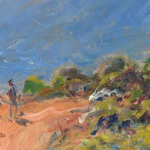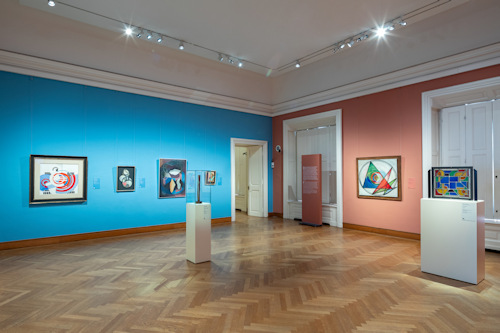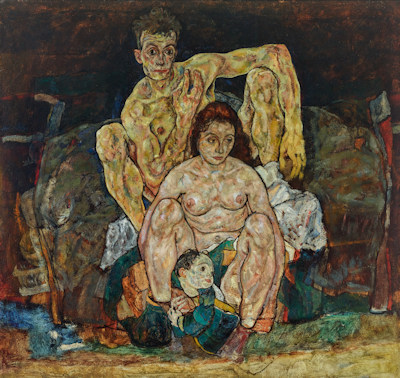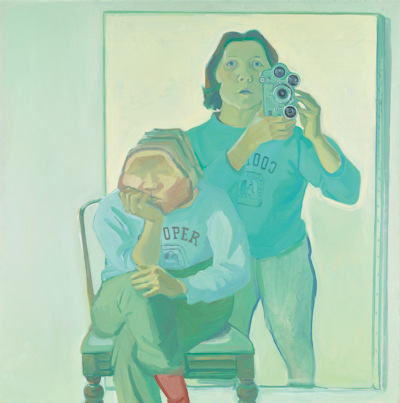
The final part of the Belvedere permanent exhibition shows the transition of Austrian (and Central European) art into the modernist era and through to recent times. As always, many jewels capture the eye.
- Selection of 20th-century art
- A journey across genres and trends
- Includes works by such giants as Hundertwasser & Schiele
- The Belvedere is a dynamic museum, so the actual works on display may vary
- All info in English and German
- Book Upper Belvedere tickets* online
- See also:
Changing face of art

(Exhibition view Picture this! The Belvedere Collection from Cranach to EXPORT; press photo courtesy of and © Johannes Stoll / Belvedere, Vienna)
The exhibition begins with early moves away from representational accuracy, then takes us through various themes and a rough chronology that ends with 20th-century Avant Garde.
We almost seem to follow along as art occupies different locations on a spectrum between reproduction and the completely abstract.
As well as offering up a selection of Austria’s best, this part of Belvedere also brings some of the talents of wider central Europe out into the light. Indeed, one thread is the language of art as a bridge builder between regions with a shared geopolitical history.
Towards modernism
The Emerging Modernism parts on the top floor include some of those names more usually found in the Vienna 1900 section, including Schiele and an unexpected (and unfinished) painting by Klimt.
Two of my favourite works by Schiele help illustrate new approaches to portraiture:
- The Family, painted in the same year (1918) both Schiele and his wife died of Spanish ‘flu. The physical expressions of the mother and father in the painting seem to anticipate this event
- Death and the Maiden (1915), another evocative and sombre portrait

(Egon Schiele, Squatting Couple (The Family), 1918; press photo courtesy of and © Johannes Stoll / Belvedere, Vienna)
The same room also has an almost fantastical and quite mesmerising 1920 image of a woman by Franz Alois Jungnickl.
Avant Garde
The Avant Garde section (go round anticlockwise) then sprinkles us with various genres and genre-spanning works.
I spent more time than I had looking at, for example, Erika Giovanna Klien’s 1939 Diving Bird, whose representation of movement proves not quite as abstract as a first glance implies.
This part introduces us to one or two works by those creators who tend to dominate the field of Austrian art in modern times; you find the likes of Arnulf Rainer or Hundertwasser, the latter represented by his 1955 224 The Large Path that once hung in the office of the Austrian chancellor if I’m not mistaken.
(The Kunst Haus Wien is an excellent tip for more works by Hundertwasser.)
The room covering the theme Persecution and Exile perhaps leaves the strongest impression: works by those murdered or driven into exile during the fascist era.

(Maria Lassnig, Double Self-Portrait with Camera, 1974; press photo: Johannes Stoll / Belvedere, Vienna; Bildrecht, 2023; Artothek des Bundes, on permanent loan to the Belvedere, Vienna © Maria Lassnig Stiftung)
Quite apart from the overriding human tragedy, this section reminds me (again) of two salient points:
- Austria’s self-inflicted loss of intellect, creativity and artistic potential
- When creativity is hindered, it does not bode well for wider society
A second Avant Garde section on the ground floor introduces a more contemporary note to Prince Eugene’s Baroque residence. However, this had made way for special exhibition space on my last visit (April 2024). Perhaps it will return between exhibitions or elsewhere in the building.
Many names here are familiar from such locations as the Bank Austria Kunstforum Wien or Albertina: Maria Lassnig, Kiki Kogelnik, Daniel Spoerri, VALIE EXPORT, and others.
These eras, genres, and artists take me even further beyond my area of expertise, but I was notably intrigued by Kogelnik’s 1975 Triangle with its representation of two women. A work that seems both serious and tongue-in-cheek, suggestive and not at all so.
It doesn’t take long to zip around the few rooms, but the trip makes a nice foray through art history and offers a breather from the crowds that often accumulate in the Klimt galleries.
P.S. If the later years of this part of Belvedere’s art interest you, consider some of the modern and contemporary art exhibitions currently on in Vienna.